There are reams of investment strategies out there for maximizing gains in a rising market and protecting ourselves when stocks tumble. But what do we do when markets simply grind sideways?
That’s what we’re going to delve into now, with three potential moves. Our favorite of these three involves buying a closed-end fund (CEF) yielding 12.8% with a payout that’s actually grown over the long haul.
September Swoon Not Unusual
So far this year, we’ve seen the S&P 500 come close to recovering 100% of its losses from last year, only to pull back in recent weeks. Even though this has made for a bit of a stressful September, it’s pretty normal; market recoveries often result in a slow and tentative return to a previous all-time high.
And even when an all-time high is breached, sometimes it takes time for markets to consistently reach new highs. In other words, we may be in for a flat market for a while.
How long could it be before we break over the top? Truth is, no one knows. And with this year’s near-15% rise and the sharp run-up in interest rates, plenty of things could cause the stock market to hesitate, and even pull back further, before getting there.
Still, stocks are eventually headed for a new high (the long-term direction of the market is up, after all). In the meantime, let’s take a closer look at three ways we can invest in a flat market, and which one works the best.
Option 1: Increase Our Cash Holding
With high-yield savings accounts offering 5% rates and CDs and Treasuries yielding around that level, this doesn’t sound like the worst idea. Plus our principal is guaranteed.
But we, of course, pass up any chance at upside. And given that the long-term direction of the market is up, we could miss out on considerable gains in the next year or two. Why do that when we can get an 8% dividend and potential price gains, too?
Option #2: Grab Higher Yields at a Discount With Bond-Focused CEFs
Right now, corporate-bond CEFs yield of 8.6% on average, and those yields have been relatively steady for a year now.
Reliably High Yields from Corporate Bonds
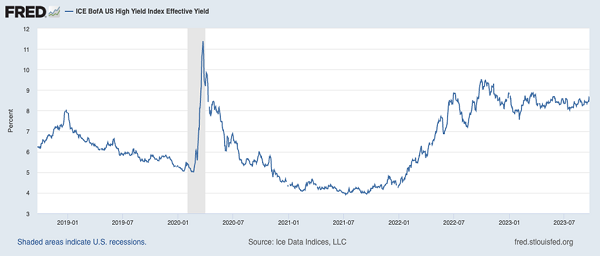
This makes it possible to turn profits from Apple (AAPL), Tesla (TSLA), and even banks like Goldman Sachs (GS) into a steady stream of income because, effectively, these firms are borrowing from us through our high-yielding bond CEFs.
Many of the funds holding these bonds were hard hit in 2022, making them attractively priced now. Consider the PIMCO Income Strategy Fund (PFL), which yields 12.8% and gave investors a 10% annualized return pretty consistently up until the 2022 selloff.
Big Profits Over the Long Haul

PFL hasn’t fully recovered from 2022 on a net asset value (NAV, or the value of its underlying portfolio) basis, as you can see in the purple line above. It currently trades at around par, which is well below its five-year average valuation of a 7% premium to NAV. (High premiums are common with PIMCO funds, as the brand is highly respected in the CEF world.)
Moreover, payouts have gone up over the long term (with the usual small fluctuations we commonly see in CEFs), with big special dividends—the spikes in the chart below—paid out in the 2000s, another higher-rate period, as well as in the lower-rate period post-2008.
12.8%-Payer Raises Dividends in All Rate Environments
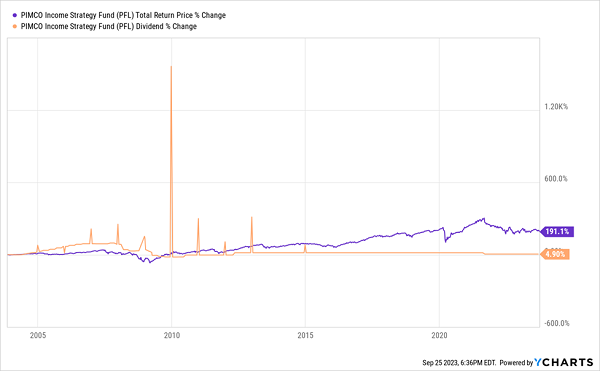
That suggests this fund eventually ends up with extra income to pay out when rates stay higher for an extended period, as they’re expected to do in the coming months, and again when rates fall, as they’re expected to do in the longer run.
In addition, over short-term flatness in a rising-rate environment, PFL, in orange below, tends to outperform the S&P 500, as it did in late 2016, when the market was recovering from a similar selloff due to rising rates.
PFL Outperforms a Flat Market
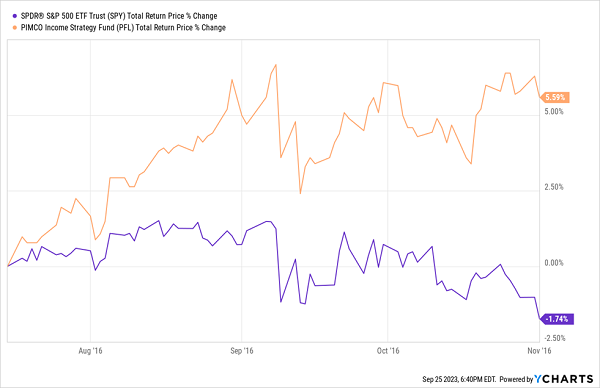
A similar scenario hasn’t played out for PFL this time around—yet. That’s because CEF investors are more cautious than stock investors, so they’ve been more reluctant to buy back in. But it’s likely coming when those same investors move off the sidelines.
Option #3: “Sell” Volatility Through a Covered-Call CEF
The most conventional way to play a flat market is to sell volatility, and the way most CEFs do this is by selling covered-call options. By doing so, they’re charging fees (“premiums” in option-speak) to buyers for the right to purchase their shares at a future date and price (or “strike price”).
But those options will expire worthless if they aren’t exercised, and buyers won’t exercise them if stocks don’t rise to meet the strike price. And no matter how that plays out, the fund keeps the premium, helping bolster its dividend payouts.
Trouble is, this strategy doesn’t always work in a flat market. To see what I mean, consider the performance of the Nuveen S&P 500 Dynamic Overwrite Fund (SPXX), which holds all the stocks in the S&P 500 but sells call options on its portfolio, in mid-2016. Its performance is in orange below, and that of the benchmark SPDR S&P 500 ETF Trust (SPY) is in purple:
Popular Covered-Call Fund Posts Sluggish Return
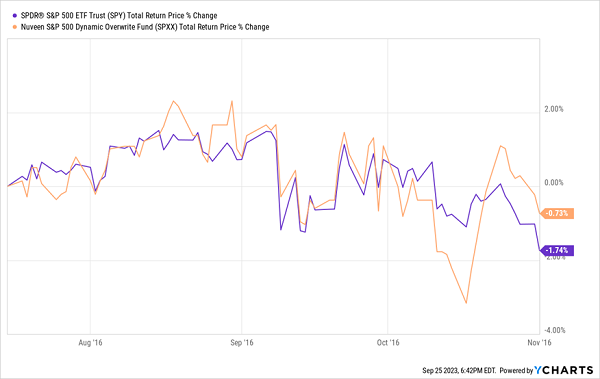
Volatility was falling in late 2016 as the market stayed flat. SPXX’s profits were there, for sure, and it was able to use them to offset the stock market’s overall drag to outperform a bit, but not much.
In 2018, however, SPXX (in blue below) did a lot better, both compared to SPY (in purple) and our bond CEF, PFL (in orange).
SPXX Outruns Bonds and Stocks in a Flat Market …

Flat stocks meant both PFL and SPXX outperformed with around a 17% and 12% annualized return for SPXX and PFL, respectively. But then something happened that showed why covered-call funds like SPXX don’t make the best longer-term investments.
… But They’re Not the Best Longer-Term Holds
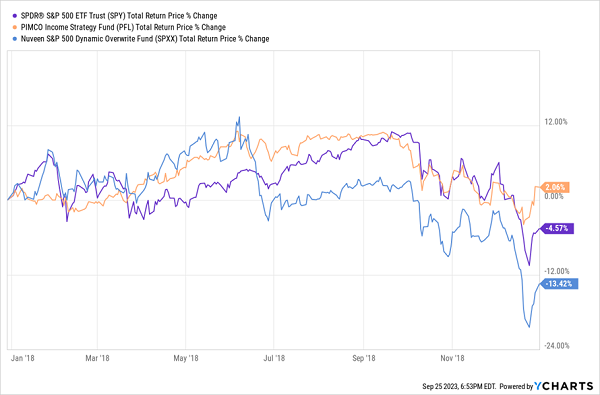
If we extend our view until later that year, we see that markets only seemed flat in early 2018 because volatility was rising as uncertainty was growing leading into a selloff, which then caused SPXX to fall behind. That doesn’t bode well for SPXX if we see more volatility from here, before stocks (inevitably) break above all-time highs again.
Conclusion: Bond CEFs Are Our Best Long-Term Buy Here
It seems clear that, of the three options in front of us, corporate bonds are an ideal way to play our current market, with higher yields than cash and more profit-making power in the long run than stocks or covered-call CEFs.
5 Monthly Dividend Funds to Buy for ANY Market (9.2% Average Payouts)
I’ve uncovered 5 funds that do something that’s nearly impossible to find in stocks, REITs, Treasuries or any other asset class: they pay dividends every single month.
They’re my top plays for whatever comes next in the markets. A rebound? We’ll happily ride along! A pullback? No problem. We’ll collect their 9.2% payout and buy more.
